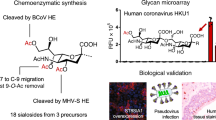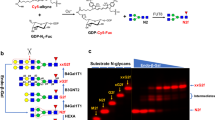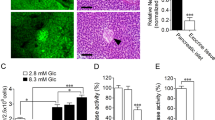Abstract
DURING the course of an investigation of the biochemical and biological properties of endotoxins extracted from various Gram-negative bacteria, chiefly several Escherichia coli strains, we found and reported briefly1 on the presence in some of these endotoxins of a material having the colour reactions of a sialic acid. The bacterial lipoproteins and lipopolysaccharides which yield this material were prepared by the phenol-water extraction method of Westphal2, separated from accompanying nucleic acid and exhaustively dialysed. The sialic acid is released from this large molecule only upon mild acid hydrolysis, and we, therefore, proposed that it forms an integral part of the cell wall of these bacteria. Members of the sialic acid group had been found previously mainly in mammalian tissue. Barry and Goebel3 had reported the elaboration of a sialic acid-like material, colominic acid, by a specific strain of E. coli. Barry4 has since reported this to be a simple polymer of N-acetylneuraminic acid.
This is a preview of subscription content, access via your institution
Access options
Subscribe to this journal
Receive 51 print issues and online access
$199.00 per year
only $3.90 per issue
Buy this article
- Purchase on Springer Link
- Instant access to full article PDF
Prices may be subject to local taxes which are calculated during checkout
Similar content being viewed by others
References
De Witt, C. W., Bact. Proc., 75, (1958).
Westphal, O., Lüderitz, O., and Bister, F., Z. Naturforschg., 7 b, 148 (1952).
Barry, G. T., and Goebel, W. F., Nature, 179, 206 (1957).
Barry, G. T., J. Exp. Med., 107, 507 (1958).
Kindly determined by Dr. W. Ewing, Communicable Disease Center, Chamblee, Georgia.
Bock, R. M., and Ling, N., Anal. Chem., 26, 154 (1954).
Svennerholm, L., Acta Chem. Scand., 12, 547 (1958)
Kindly supplied by Dr. D. Comb, University of Michigan, and Dr. F. Zilliken, University of Pennsylvania. Both obtained from E. coli k235 and are identical in our hands.
Kindly supplied by Dr. G. Blix, University of Uppsala. Extracted from bovine submaxillary mucin and is presumably the 7-O-acetyl derivative of NANA.
Klenk, E., and Uhlenbruck, G., Z. physiol. Chem., 307, 266 (1957).
Svennerholm, E., and Svennerholm, L., Nature, 181, 1154 (1958).
Stadtman, E. R., and Barker, H. A., J. Biol. Chem., 184, 769 (1950).
Comb, D. G., and Roseman, S., J. Amer. Chem. Soc., 80, 497 (1958).
Cardini, C. E., and Leloir, L. F., J. Biol. Chem., 225, 317 (1957).
Weidel, W., and Primosigh, J., Z. Naturforsch., 12 b, 421 (1957).
Work, E., Nature, 179, 841 (1957).
Barry, G. T., Nature, 183, 117 (1959).
Author information
Authors and Affiliations
Rights and permissions
About this article
Cite this article
DE WITT, C., ROWE, J. N,O-Diacetylneuraminic Acid and N-Acetylneuraminic Acid in Escherichia coli . Nature 184, 381–382 (1959). https://doi.org/10.1038/184381b0
Issue Date:
DOI: https://doi.org/10.1038/184381b0
This article is cited by
-
Sialic Acid in Pasteurella pestis
Nature (1962)
-
Nonulosaminic Acid (Sialic Acid) in Protists
Nature (1960)
-
Chemical and Serological Relationships of Certain Bacterial Polysaccharides Containing Sialic Acid
Nature (1960)
Comments
By submitting a comment you agree to abide by our Terms and Community Guidelines. If you find something abusive or that does not comply with our terms or guidelines please flag it as inappropriate.



